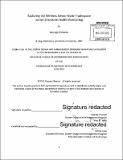Exploring the wireless sensor node tradespace within Structural Health Monitoring
Author(s)
Clernon, George
DownloadFull printable version (14.46Mb)
Other Contributors
System Design and Management Program.
Advisor
Patrick Hale.
Terms of use
Metadata
Show full item recordAbstract
Historically, Structural Health Monitoring (SHM) involved visually or acoustically observing a structure and if damage was detected, remedial action was undertaken to repair or replace it. For example, as early as 6,500 BC, potters were known to listen for audible sounds during the cooling of their ceramics, signifying structural failure. In 1864 the UK parliament legislated for dam monitoring after a dam failure lead to the deaths of 254 people. The Golden Gate and Bay Bridges in San Francisco were monitored by Dean S. Carder in 1937 to determine "the probabilities of damage due to resonance" during an earthquake. Given the technological limitations of the last century, the predominant focus of SHM has been on identifying and understanding the global modal properties of a structure. However, the promise of SHM is the detection of any damage to infrastructure at the earliest possible moment from an array of sensors and actuators. To achieve this goal, not only global but local facets of the structure must be monitored. If this promise is realized, it will be possible to design bridges closer to their tolerances, to extend their operational lives, and to switch servicing to more cost-effective condition based maintenance. Such changes will reduce construction and maintenance costs while still providing the same level of service. This thesis will explore the wireless sensor node tradespace with the specific intent of delving into the areas limiting large scale, high density, localized coverage of structural health monitoring of bridges.
Description
Thesis: S.M. in Engineering and Management, Massachusetts Institute of Technology, Engineering Systems Division, System Design and Management Program, 2015. Cataloged from PDF version of thesis. Includes bibliographical references (pages 69-74).
Date issued
2015Department
System Design and Management Program.; Massachusetts Institute of Technology. Engineering Systems DivisionPublisher
Massachusetts Institute of Technology
Keywords
Engineering Systems Division., System Design and Management Program.